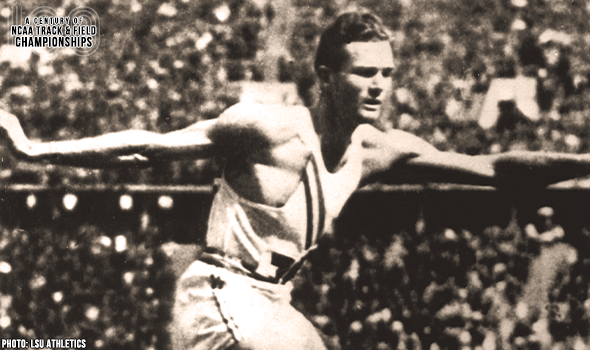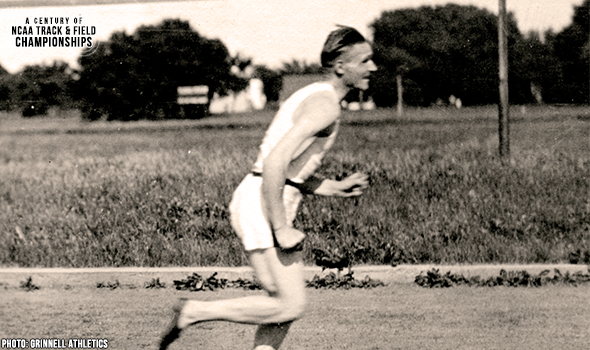
LSU’s Hardin Completed Unique 440-220H Double Twice
Glenn Hardin of LSU had a debut never seen before at the 1933 NCAA Outdoor Track & Field Championships at Chicago’s Soldier Field.
Hardin was just a sophomore when he entered an unlikely combination of events, the 440 yards and 220-yard hurdles. Hardin owned the year’s world-leading performances in both events, and his unique background meant running both – and well – on the same day was possible.
The LSU standout owned the world record and Olympic silver medal in the 400-meter hurdles, an event that was still a few years away from being offered on the NCAA’s championship menu. He earned the WR and medal the previous summer at the Los Angeles Olympics (the gold medalist’s time wasn’t eligible then for a record because of a knocked-over hurdle).
The closest call for Hardin in the NCAA meet came in the 440, but his meet-record 47.1 was a new world-leading mark and just held off Ivan Fuqua of Indiana and Ed Ablowich of Southern California. The previous summer Fuqua and Ablowich ran the opening two legs of the gold-medal winning U.S. 4×400 relay team at the Los Angeles Olympics.
Less than an hour later, Hardin was back on the track, skimming over the 220 hurdles – 6 inches lower than the 400 intermediates – in 22.9 to match his own world-leading time. Both of Hardin’s 22.9 times were faster than the ratified world record of 23.0 at the time, but neither received official recognition.
Hardin’s team-high 20 points were important for LSU, which would end up winning the team crown by four points in an upset over USC. You might also remember that Matt Gordy notched a walk-off victory in the pole vault to give the Tigers the decisive margin.
The 1934 season saw more of the same uniqueness from Hardin, except that the man known as “Slats” was even faster (He gained the nickname in high school because he was so tall and thin, like the slats for a bed).
Though Fuqua gained an early-season victory on Hardin’s home track in a dual meet, Hardin came through with another NCAA meet record as the meet moved away from Chicago for the first time. Running again at the Los Angeles Memorial Coliseum, Hardin won the 440 in 47.0, and no one was close in the 220 hurdles as he lowered the world best to 22.7 (again unratified).
Hardin proved most formidable in the 400-meter hurdles during the summer of 1934, lowering his world record to 50.6, a mark that would stand for 19 years.
His collegiate career ended in 1935 after another remarkable effort at the NCAA Outdoor Championships, but this time he found his match in each event. Hardin finished third in the 440 (UCLA’s Jimmy LuValle won) and runner-up in the 220 hurdles to Jesse Owens of Ohio State.
As a post-collegian in 1936, Hardin won Olympic gold in the 400 hurdles in Berlin. By 1964, the 400H was regularly on the NCAA schedule and his son Billy won the title for LSU, completing the meet’s first father-son combination of NCAA champions. Billy’s time, a meet-record 50.2, gave him the family best.
The NCAA and collegiate track & field will mark a momentous milestone in the spring of 2021 -- the 100th anniversary of the NCAA Championships and with that, the NCAA Track & Field Championships. In June 1921, the University of Chicago hosted the first track & field championships in NCAA history.
This point can’t be emphasized enough: Not only was the event the first for NCAA track & field, but the first championships for any sport under the sponsorship of the NCAA.
To celebrate, over each of the next 365 days, the U.S. Track & Field and Cross Country Coaches Association (USTFCCCA) will celebrate moments, student-athletes, and coaches that have made a century’s worth of championships special. From humble beginnings to important historical milestones to the modern-day, collegiate track & field has evolved with the American society.
The 2021 edition of the NCAA Division I Outdoor Track & Field Championships begin with preliminary round action on May 27-29 in Jacksonville, Fla., and College Station, Texas. The championships final site and culmination of the celebration is slated for June 9-12, 2021 at the newly rebuilt Hayward Field in Eugene, Ore.

SIU’s Roggy Dominated The Javelin In 1978
Bob Roggy won the javelin title at the 1978 NCAA DI Outdoor T&F Championships by more than 20 feet. Roggy qualified first for the final with a MR heave of 89.30m (293‑0).

Makusha Made History In Bowerman Year Of 2011
Ngoni Makusha became just the fourth man in meet history to win individual titles in both the 100 and LJ. It was his 3rd career LJ crown and he set a CR in the 100 of 9.89.

George Mason’s Gage Shocked The NCAA LJ In 1988
Nena Gage won the long jump at the 1988 NCAA DI Outdoor T&F Championships in a shocking upset over Gail Devers.

Texas’ Thompson Marveled In NCAA Distance Events
Jerry Thompson won three career distance titles at the NCAA Outdoor T&F Championships. His first came in 1943. Then he won again in 1947 & 1948 after serving in World War II.

Grinnell’s Paulu Sprinted To NCAA History
Leonard Paulu was the first athlete to complete the 100-200 double in NCAA Outdoor Track & Field Championships history in 1922. That also made him the 1st to win back-to-back 100 titles, too.

Scott Won Back-To-Back NCAA Hammer Titles
Candice Scott won back-to-back hammer throw titles at the NCAA DI Outdoor T&F Championships in 2003 & 2004. Scott set a meet record of 69.77m (228-11) in that first year.

Drouin Soared To The Bowerman In 2013
Derek Drouin won two career HJ titles at the NCAA DI Outdoor T&F Championships. When Drouin won in 2013, he was only the fourth man to clear 2.34m (7-8) in meet history.

Watts Made Quick Work Of NCAA 400
Quincy Watts set a meet record in the 400 of 44.00 at the 1992 NCAA DI Outdoor Track & Field Championships. It lasted 25 years until 2017.

Iowa State’s Koll Rolled To 5K-10K Crowns
Lisa Koll won three career titles at the NCAA DI Outdoor T&F Championships in dominant fashion. Her average margin of victory in those 5K & 10K races was 37.73 seconds.

LSU’s Hardin Completed Unique 440-220H Double Twice
The nearly unheard of 440-220H double was so nice that Glenn Hardin did it twice! Hardin became the first to do so in meet history in 1933 and then swept them again in 1934.

